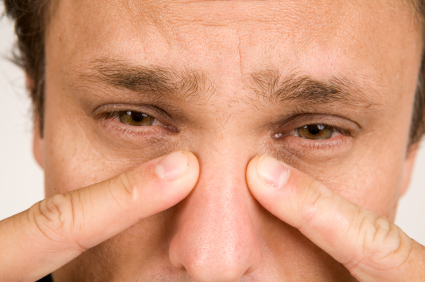What Are Sinuses?
You know the expression, “I need this like I need a hole in the head”? Well it just so happens that, while you may not actually need a sinus infection, you actually do need holes in the head, and you already have them—eight of them, to be exact. Sinuses are nothing more than hollow, air-filled cavities that filter air, secrete mucous, and keep the skull light and insulated, by reducing the weight of the skull. In addition, sinuses give the voice a sounding board on which to resonate and amplify.
What Causes a Sinus Infection?
We don’t think much about our sinuses until they start giving us grief, but then and when they do, it’s impossible to think about anything else. Sinuses are located in the forehead, behind the eyes, between the eyes, and behind the cheekbones. The mucous membranes of the nose tend to swell with allergies, sudden changes in humidity, pollutants, or upper respiratory infections. When this swelling occurs, or when structural problems from birth or from trauma cause a block, or when the mucous membranes of the nose swell, as they do with allergies, sudden change in humidity, pollutants or upper respiratory infections, here’s what can happen: the sinus openings into the nose get blocked and the mucous, being that’s made in the sinuses, can’t get out. This mucous can cause pain and pressure even when there is no infection. If the mucous is trapped long enough, then the pH inside the sinus changes, the mucous membranes become more swollen and inflamed, and the sinus cavity can become a breeding ground for bacteria. Sinuses can independently get infected (sinusitis) due to a virus, like a cold, or due to bacteria and fungi.
When any of these triggers damage the cells that line the sinus cavity, inflammation results. The lining swells inside the sinus cavity and inside the nose. This blocks the openings of the sinus cavity so fluids can’t drain properly and trapped bacteria begin to multiply. The build- up of fluid can cause pressure and headache that is felt in the eyes, nose, cheek area, or on one side of the head. In addition, someone with sinusitis might have a cough, nasal congestion, fever, and perhaps bad breath.
What Are the Symptoms of Sinusitis?
Do you have nasal congestion and discharge? Pain in the forehead, cheeks or even the teeth? Post-nasal drip possibly accompanied by bad breath? Coughing, throat clearing, or sore throat? These symptoms may be signs of sinusitis. Each year, doctors diagnose nearly 12 million sinus infections. Another 3.7 million upper respiratory infections, 72.4 million coughs, and 17.5 million sore throats are diagnosed yearly. It is no wonder that Forbes magazine noted that complaints in the ears, nose, and throat issues are in as among the top ten most common medical complaints.
How Is Sinusitis Diagnosed?
If you suffer from any of the following symptoms: allergies, sneezing, itchy nose, runny nose, scratchy throat, watering eyes, nasal airway obstruction, facial pain, decreased sense of smell, post-nasal drip, chronic cough or throat clearing, the feeling of a lump in the throat that is difficult to swallow, or difficulty with your speaking or singing voice—you should see an otolaryngologist, like Dr. Yagoda, who specializes in the care of the ear, nose, and throat in her New York, NYC, and Manhattan.
Many general practitioners and allergists are unable to properly diagnose structural problems in the nose and sinuses, as they do not have the proper instrumentation to view the nose and sinuses. Without a full examination, it may be impossible to make the correct diagnosis. This may result in treatment with unnecessary antibiotics. While antibiotics can be useful against bacteria, some sinus infections are viral in origin or have other causes. It’s therefore important to track down the cause of the infection to treat with the correct therapy.
Are There Different Types of Sinusitis?
There are two kinds of sinusitis, acute and chronic. Sinusitis is considered acute when it has a sudden onset and resolves completely; chronic sinusitis, the more common variety, tends to hang around. It might ebb and flow in severity, but it never completely resolves. Oftentimes, there are structural problems in the nose and/or sinus cavities that prevent full clearing of the sinusitis. There may even be nasal polyps, typically a benign (non-cancerous) growths that are akin to tiny water balloons. These may block the sinus drainage and cause infections to linger.
What Are the Treatments for Sinusitis?
• Lifestyle and dietary changes
• Alternative, herbal, and homeopathic remedies
• Medical treatments
• Balloon sinus surgery
• Endoscopic surgery
As both an otolaryngologist and facial plastic surgeon, Dr. Yagoda is able to offer her patients in New York, NYC, and Manhattan a full spectrum of care for relief of both acute and chronic sinus infections and for treatment of the ears, nose, throat, voice, head, and neck. Read more about the treatments for sinusitis.



































